I expect many of you may have already started wondering what the heck I am talking about, so please allow me give you a little background. In 1998 three prominent theorists -Arkani-Hamed, Dimopoulos and Dvali- put forth a hypothesis of the existence of large spatial extra-dimensions -where "large" means large on a microscopic scale, but still undetectable in everyday life. Their idea was that if extra dimensions existed beyond the three spatial ones we feel we live in, a few problems of our current understanding of subnuclear physics could be solved.
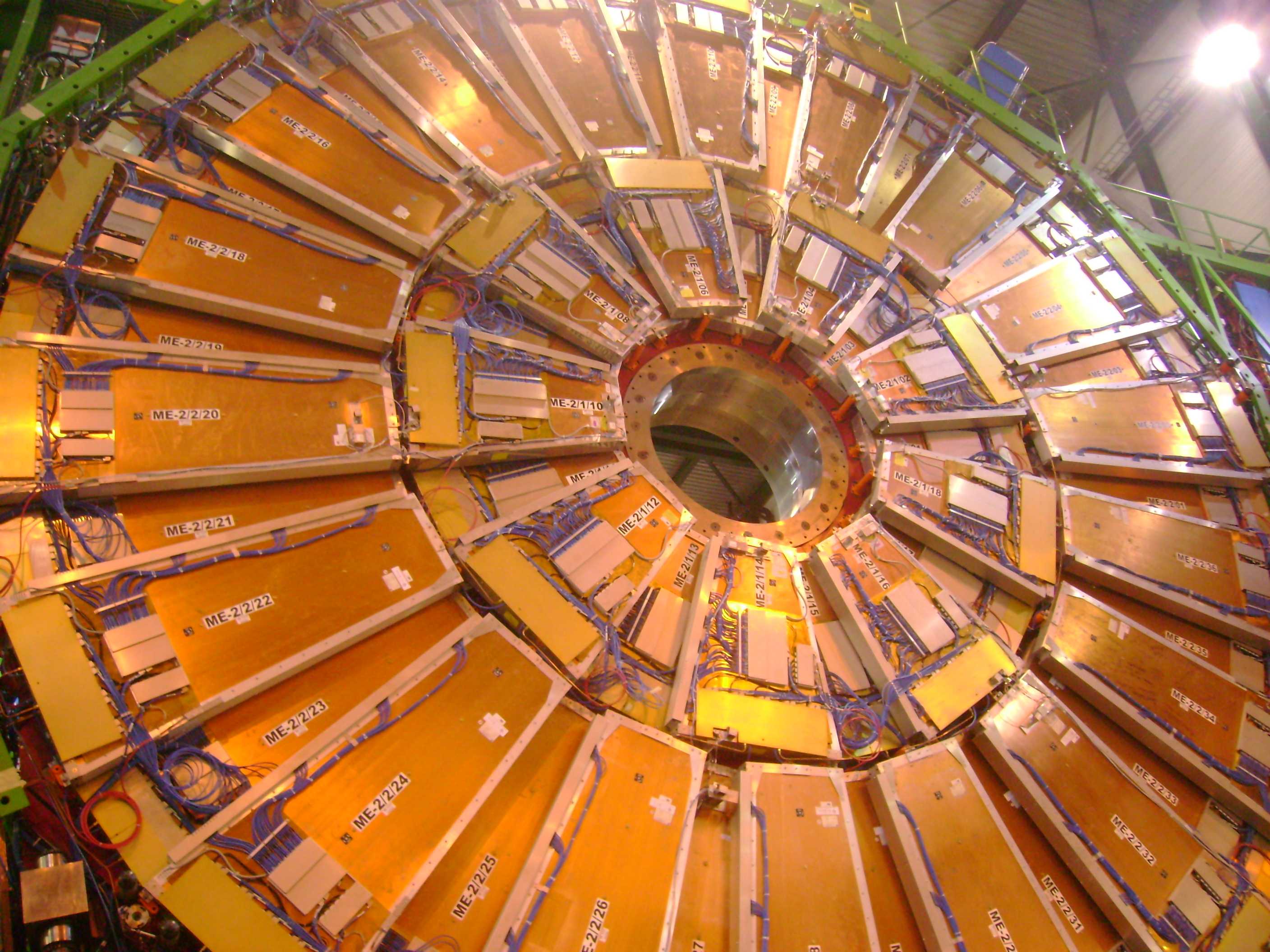 If extra spatial dimensions existed, we could have missed them if they were still small for us -on the scale of a millimeter or less. General physics experiments, such as tests of the law of gravity at the millimeter scale -which could be revealing because these additional space dimensions would cause the breaking down of the inverse square law of gravitational attraction- are hard to perform, so the possibility is still there that they exist. And to such a length of scale there corresponds a specific energy at which the resulting effects on subnuclear physics might become evident: it turns out that such energy is one reachable by the LHC experiments.
If extra spatial dimensions existed, we could have missed them if they were still small for us -on the scale of a millimeter or less. General physics experiments, such as tests of the law of gravity at the millimeter scale -which could be revealing because these additional space dimensions would cause the breaking down of the inverse square law of gravitational attraction- are hard to perform, so the possibility is still there that they exist. And to such a length of scale there corresponds a specific energy at which the resulting effects on subnuclear physics might become evident: it turns out that such energy is one reachable by the LHC experiments.One of the reasons why the theory is appealing is that it explains away one of the riddles we try to forget about -the fact that gravity is so weak if compared to the three other forces of Nature. In fact, gravity does not even enter in the Standard Model of particle physics, because it is irrelevant there -particles feel electromagnetic, weak, and strong interactions with a strength many orders of magnitude larger than their gravitational interaction.
If extra dimensions exists, the explanation becomes obvious: gravity is weak because it extends into the other dimensions, while we live on a four-dimensional "sheet" (a brane) in this multi-dimensional space. If you have not studied quantum mechanics, the above could still sound mysterious, but just think of a drop of red dye on a pool of water, and a drop of oil on the same pool. You can see the oil because it distributes on a thin layer (our "brane" if we are lake bugs), but you will not easily detect a reddening of the whole water volume, because the drop of dye mixes with all of it (the bulk). Now, if we live on the surface of the water, to us the drop of paint makes little difference, while we do feel the layer of oil!
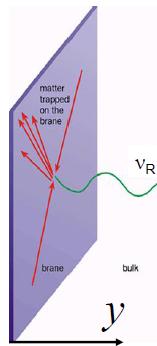 Large extra dimensions have been repeatedly searched at the Tevatron collider by the CDF and DZERO experiments with the large datasets of proton-antiproton collisions they collected so far, with little success. The clearest signature consists in a quark or a gluon of very high energy, which recoils at large angle from the colliding beams, against a hypothetical graviton. What you see is a narrow jet of collimated hadrons produced when the quark or gluon fragments into observable particles, and nothing on the side opposite to the jet: the graviton left our three dimensions to enter the "bulk" of extra dimensions off the three-dimensional sheet where we live.
Large extra dimensions have been repeatedly searched at the Tevatron collider by the CDF and DZERO experiments with the large datasets of proton-antiproton collisions they collected so far, with little success. The clearest signature consists in a quark or a gluon of very high energy, which recoils at large angle from the colliding beams, against a hypothetical graviton. What you see is a narrow jet of collimated hadrons produced when the quark or gluon fragments into observable particles, and nothing on the side opposite to the jet: the graviton left our three dimensions to enter the "bulk" of extra dimensions off the three-dimensional sheet where we live.The signature of a jet of high energy apparently violating the conservation of total momentum is striking, and there are very few -and rare- known processes that can give rise to it. The violation of momentum arises because the protons collide along the beam axis -let us take it to be the z axis- and thus the initial state has zero momentum in the xy plane; on the other hand, the high-energy jet carries away momentum largely in the xy plane, and is not balanced by anything recoiling in the opposite direction.
The paper by CMS is interesting and discusses a promising avenue for finally finding new physics beyond the Standard Model. It focuses on data collectable by the LHC experiments during 2010, making the hypothesis that by the end of next year we will have 200 inverse picobarns of 10-TeV proton-proton collisions to analyze in search for a LED signature. 200 inverse picobarns are about 20 trillion proton-proton collisions, but since these large extra dimensions hide at high energy -corresponding to the smallness of these additional dimensions of space-, only few events would be seen attributable to those processes.
Despite the fact that CDF and DZERO already have thirty times more data to work on, the CMS reach on LEDs is significantly larger, because of the five-fold increase in energy. This is due to the fact that we are considering an effect that "turns on" at high energy, and so the Tevatron might indeed be simply unable to ignite it. So far, CDF and DZERO have only excluded LEDs up to a energy scale of about 1 TeV (1.4 TeV for the most significant search, but only for the case of two extra dimensions).
The figure below shows a distribution of the MHT, the variable which will be studied by CMS in its 2010 dataset to search for large extra dimensions. MHT is a vectorial sum of the jet momenta in the transverse plane, and it is shown for events coming from several background sources and for the signal. The vectorial sum in the xy plane should be small -consistent with zero within experimental errors- if there is no particle leaving the detector unseen (such as is the case for the background labeled "QCD" and shown in purple); in case of a graviton escaping to other dimensions (the blue histogram), the MHT is instead large.
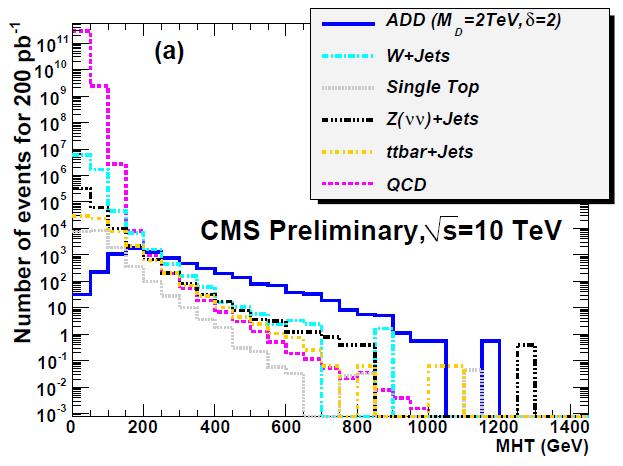
Of course, many background processes have to be studied to size up the expected yield of "suspicious" events. The nastiest is the production of a Z boson recoiling against a high-energy jet: when the Z boson decays to a pair of neutrinos -something that happens about 20% of the time- it effectively "disappears" much like the graviton, since neutrinos do not interact with the detector and leave unseen, producing a large value of MHT. The CMS analysis demonstrated that such a background can be sized up by studying a similar process, the production of a W boson plus a jet. By counting W decays to a muon-neutrino pair, and computing the MHT it produces if we ignore the muon in the sum, we can estimate the Z->nu nu + jet background in a way which is much less reliant on Monte Carlo simulations. This is illustrated in the figure below, where you can see the MHT distribution one would be looking at with 200/pb of data, due to the irreducible Z background (estimated by MC, in red). This is compared to the estimate produced by the analysis of W events discussed in the paper (in blue), a "data-driven" method. The two distributions match closely, demonstrating the correctness of the method.
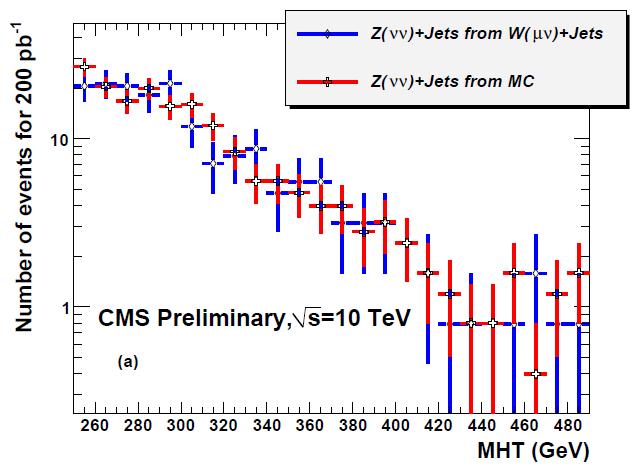
The final result of the analysis is the table below, showing the discovery reach for LEDs as a function of the scale of the extra dimensions,

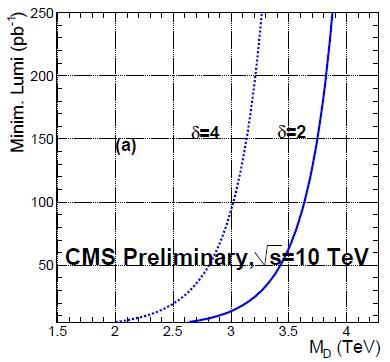 Another way to see the reach of CMS is to plot the integrated luminosity that is needed in order to find large extra dimensions, as a function of their mass scale, and for different values of the parameter delta (the number of extra dimensions). This is shown in the figure on the right.
Another way to see the reach of CMS is to plot the integrated luminosity that is needed in order to find large extra dimensions, as a function of their mass scale, and for different values of the parameter delta (the number of extra dimensions). This is shown in the figure on the right.On a personal note, I have to say that the paper is very carefully written, both in form and content. That, of course, is because I was the chair of the review committee who sheperded it to publication... Jokes aside, I wish to thank the authors of this important new study for their work and for the patience with which they dealt with the comments and corrections my review committee continued to send them until the last minute. The main authors of the study are L. Benucci, M. Cardaci, A. De Roeck, U. Enrah Surat, L. Sala, and L. Vergili.



Comments